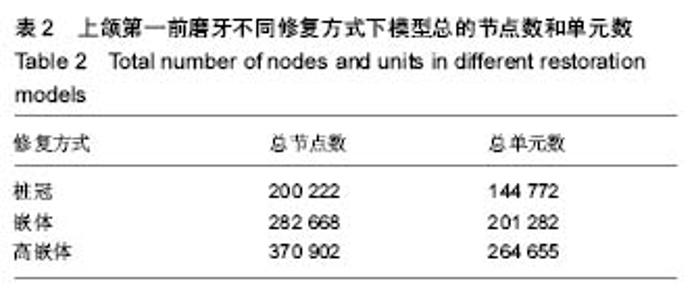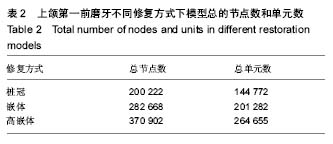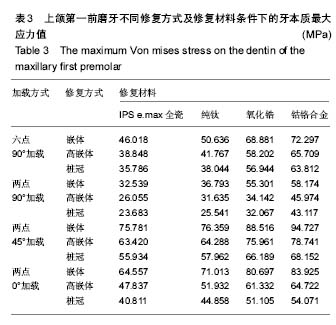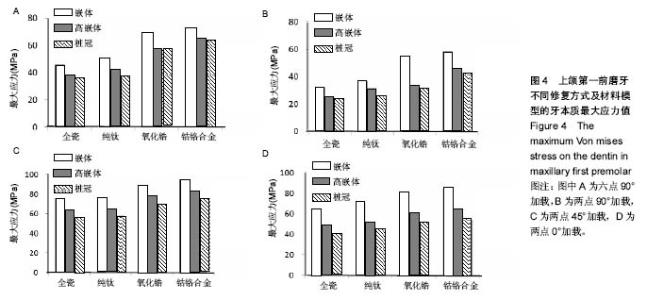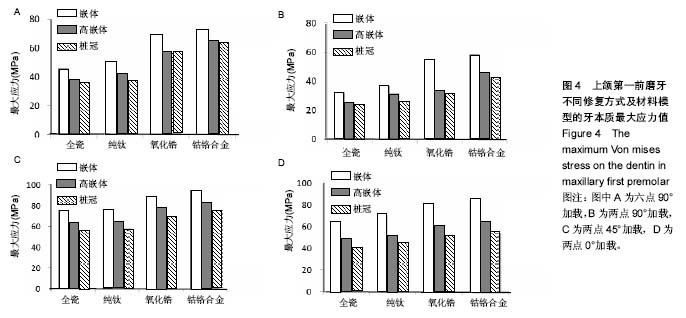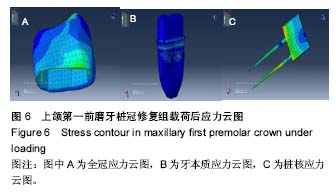Chinese Journal of Tissue Engineering Research ›› 2018, Vol. 22 ›› Issue (6): 858-864.doi: 10.3969/j.issn.2095-4344.0059
Previous Articles Next Articles
Restoration of maxillary premolars: a finite element analysis of three repair methods and four kinds of dental restoration materials
- 1Department of Stomatology, Peking University First Hospital, Beijing 100034, China; 2Department of Stomatology, Beijing Haidian Hospital, Beijing 100080, China
-
Received:2017-09-15Online:2018-02-28Published:2018-02-28 -
About author:Fu Hong-yu, Master, Attending physician, Department of Stomatology, Peking University First Hospital, Beijing 100034, China
CLC Number:
Cite this article
Fu Hong-yu, Feng Guang-zhi. Restoration of maxillary premolars: a finite element analysis of three repair methods and four kinds of dental restoration materials[J]. Chinese Journal of Tissue Engineering Research, 2018, 22(6): 858-864.
share this article
Add to citation manager EndNote|Reference Manager|ProCite|BibTeX|RefWorks
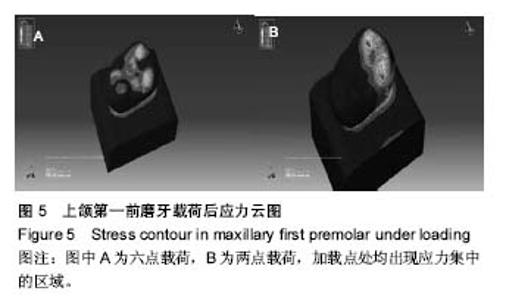
2.3 应力分布图 4种加载条件下,无论是六点载荷还是两点载荷,均可见加载点处均出现应力集中的区域,见图5。 4种加载条件下,桩冠修复后应力集中的主要区域位于预备体的肩台、修复体边缘、剩余牙本质颈部及桩核中部,不同载荷下的应力集中区稍有不同,见图6。 4种加载条件下,嵌体修复后,应力集中区主要出现在嵌体及对应牙本质预备体的龈壁和底面与二者移行处,釉质的应力集中区主要在加载点处,并沿牙釉质将应力传到至颈部。嵌体修复后各部分应力分布见图7。 4种加载条件下,髓腔固位型高嵌体修复后,应力集中区除了主要出现在高嵌体髓腔内部分及对应牙本质预备体的龈壁和底面与二者移行处,还可见到高嵌体与牙釉质对应处也出现应力集中区,应力分布更为均匀,高嵌体修复后,各部分应力分布见图8。"
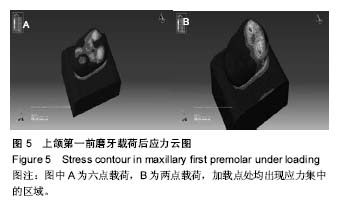
| [1]Dejak B,M?otkowski A.3D-Finite element analysis of molars restored with endocrowns and posts during masticatory simulation.Dent Mater.2013;29(12):e309-317. [2]Frankenberger R,Zeilinger L,Krech M,et al.Stability of endodontically treated teeth with differently invasive restorations:adhesive vs non-adhesive cusp stabilization.Dent Mater.2015;31(11):1312-1320.[3]Juloski J,Apicella D,Ferrari M.The effect of ferrule height on stress distribution within a tooth restored with fibre posts and ceramic crown: a finite element analysis.Dent Mater. 2014; 30(12):1304-1315.[4]Huang SF,Chen WR,Lin CL.Biomechaniacl interactions of endodontically treated tooth implant-supported prosthesis under fatigue test with acoustic emission monitoring.Biomed Eng Online.2016;15:23.[5]Y Qian M,Zhong Q,Chen S.Composite of clinical effects of Co-Cr alloy cast post-core and everstick fiber post in restoration of labially or lingually inclined maxillary central incisor.[J].Shanghai Kou Qiang Yi Xue.2017;26(1):89-93. [6]Szeftel M.Fracture resistance of teeth restored with all-ceramic inlays and onlays: an in vitro study.Oper Dent. 2013;38(6):626-634. [7]Madhavareddy SH,Mynampati P,Mandava RB,et al.The effect of cavity design on fracture resistence and failure pattern in monolithic zirconia partial coverage restorations-an in vitro study.J Clin Diagn Res.2017;11(5):zc45-zc48.[8]Guo L,Wang XJ,Wan R,et al.Clinical application of gold alloy onlay on restoration of molars with severe attrition.Chin J Prosthodont.2016.[9]Yu HY,Ma DD,Lin XY,et al.The clinic outcome of CAD/CAM onlay in the restoration of molars with extensive defect after root canal treatment.J Pract Stomatol.2017;33:41-44.[10]Lee KS, Shin JH, Kim JE,et al.Biomechanical evaluation of a tooth restored with high performance polymer pekk post-core system:a 3D finite element Analysis.Biomed Res Int. 2017; 2017:1373127.[11]Toniollo MB,Macedo AP,Pupim D,et al.Finite element analysis of bone stress in the posterior mandible using regular and short implants,in the same context with splinted and nonsplinted prostheses.Int J Oral Maxillofac Implants.2017; 32(4):e199-e206.[12]刘涛,耿海霞.下颌第一磨牙不同桩核位置数目金合金桩核修复后基牙应力的三维有限元分析[J].中国组织工程研究, 2017, 21(22):3501-3506.[13]王惠芸.我国人牙的测量和统计[J].中华口腔科杂志, 1959,7(3): 149.[14]Wendler M,Belli R,Petschelt A,et al.Chairside CAD/CAM materials.Part 2: flexural strength testing.Dental Mater.2017; 33(1):99-109.[15]Lin CL,Chang YH,Pa CA.Estimation of the risk of failure for an endodontically treated maxillary premolar With MODP preparation and CAD/CAM ceramic restorations.J Endod. 2009;35(10):1391-1395. [16]Aversa R,Apicella D,Perillo L,et al.Non-linear elastic three-dimensional finite element analysis on the effect of endocrown material rigidity on alveolar bone remodeling process.Dent Mater. 2009;25(5):678-690. [17]Jiang W,Bo H,Yongchun G,et al.Stress distribution in molars restored with inlays or onlays with or without endodontic treatment: a three-dimensional finite element analysis.J Prosthet Dent. 2010;103(1):6-12.[18]Lin CL,Chang YH,Chang CY,et al.Finite element and Weibull analyses to estimate failure risks in the ceramic endocrown and classical crown for endodontically treated maxillary premolar.Eur J Oral Sci.2010;118(1):87-93. [19]Maceri F,Martignoni M,Vairo G.Mechanical behaviour of endodontic restorations with multiple prefabricated posts:a finite-element approach.J Biomech.2007;40(11):2386-2398.[20]Nakamura T,Imanishi A,Kashima H,et al. Stress analysis of metal-free polymer.Prosthodontics. 2000;14(5):401-405.[21]Teixeira EC,Teixeira FB,Piasick JR,et al.An in vitro assessment of prefabricated fiber post systems.J Am Dent Assoc.2006;137(7):1006-1012. [22]Yang X,Tang Z,Wei Y,et al.3D finite element analysis on the effect of MOD cavity design of maxillary first premolar on restoration with all ceramic inlays.Chin J Dent Mater Dev. 2017;3:129-133.[23]Yamamoto T,Takeishi S.Finite element stress analysis of indirect restoration prepared in cavity bases.Dent Material J.2007;26(2):274-279.[24]Peumans M,Valjakova EB,De MJ,et al.Bonding effectiveness of luting composites to different CAD/CAM materials.J Adhesive Dent.2016;18(4):289.[25]Lin CL,Chang WJ,Lin YS,et al.Evaluation of the relative contributions of multi-factors in an adhesive MOD restoration using FEA and the Taguchi method-Dental Materials.Dent Mater.2009;25(9):1073-1081.[26]Parlar Z,Gokcek EU,Yildirim K.A Kahyaoglu.Influence of cavity design on stress distribution in second premolar tooth using finite element anylysis.Acta Physica Polonica A. 2017; 132(3):949-953.[27]Mei ML,Chen YM,Li H,et al.Influence of the indirect restoration design on the fracture resistance:a finite element study.Biomed Eng Online.2016;15:3.[28]Varga S,Spalj S,Lapter Varga M,et al.Maximum voluntary molar bite force in subjects with normal occlusion.Eur J Orthod.2011;33(4):427-433.[29]Lundgren D,Laurell L.Occlusal force pattern during chewing and biting in dentitions restored with fixed bridges of cross-arch extension.I.Bilateral end abutments.J Oral Rehabil.1986;13(1):57-71.[30]Gibbs CH,Mahan PE,Lundeen HC,et al.Occlusal forces during chewing and swallowing as measured by sound transmission.J Prosthet Dent.1981;46:443-449.[31]Koolstra JH,van Eijden TM, Weijs WA,et al.A three-dimensional mathematical model of the human masticatory system predicting maximum possible bite forces. J Biomech. 1988;21(7):563-576.[32]单辉祖.材料力学(4)[M].北京:高等教育出版社,2016:255.[33]陈新民.牙本质的力学性质[J].国际口腔医学杂志, 1989,16(1): 20-24.[34]林红.口腔材料学[M].北京:北京大学医学出版社,2013.[35]Su C,Su Y,Li Z,et al.In situ synthesis of bilayered gradient poly (vinylalcohol) /hydroxyapatite composite hydrogel bydirectional freezing-thawing and electrophoresis method. Mater Sci Eng C Mater Biol Appl.2017;77:76-83.[36]Han SH,Sadr A,Tagami J,et al.Internal adaptation of resincomposites at two configurations: Influence ofpolymerization shrinkage and stress.Dent Mater. 2016;32(9): 1085-1094.[37]Fronza BM,Rueggeberg FA,Braga RR,et al. Monomerconversion, microhardness, internal marginal adaptation, and shrinkage stress of bulk-fill resin composites. Dent Mater.2015;31(12):1542-1551.[38]Dejak B,Mlotkowski A.Three-dimensional finite element analysis of strength and adhesion of composite resin versus ceramic inlays in molars.J Prosthet Dent.2008;99(2):131-140. |
| [1] | Zhang Tongtong, Wang Zhonghua, Wen Jie, Song Yuxin, Liu Lin. Application of three-dimensional printing model in surgical resection and reconstruction of cervical tumor [J]. Chinese Journal of Tissue Engineering Research, 2021, 25(9): 1335-1339. |
| [2] | Chen Xinmin, Li Wenbiao, Xiong Kaikai, Xiong Xiaoyan, Zheng Liqin, Li Musheng, Zheng Yongze, Lin Ziling. Type A3.3 femoral intertrochanteric fracture with augmented proximal femoral nail anti-rotation in the elderly: finite element analysis of the optimal amount of bone cement [J]. Chinese Journal of Tissue Engineering Research, 2021, 25(9): 1404-1409. |
| [3] | Zeng Yanhua, Hao Yanlei. In vitro culture and purification of Schwann cells: a systematic review [J]. Chinese Journal of Tissue Engineering Research, 2021, 25(7): 1135-1141. |
| [4] | Cai Qunbin, Zou Xia, Hu Jiantao, Chen Xinmin, Zheng Liqin, Huang Peizhen, Lin Ziling, Jiang Ziwei. Relationship between tip-apex distance and stability of intertrochanteric femoral fractures with proximal femoral anti-rotation nail: a finite element analysis [J]. Chinese Journal of Tissue Engineering Research, 2021, 25(6): 831-836. |
| [5] | Song Chengjie, Chang Hengrui, Shi Mingxin, Meng Xianzhong. Research progress in biomechanical stability of lateral lumbar interbody fusion [J]. Chinese Journal of Tissue Engineering Research, 2021, 25(6): 923-928. |
| [6] | Liu Zhao, Xu Xilin, Shen Yiwei, Zhang Xiaofeng, Lü Hang, Zhao Jun, Wang Zhengchun, Liu Xuzhuo, Wang Haitao. Guiding role and prospect of staging and classification combined collapse prediction method for osteonecrosis of femoral head [J]. Chinese Journal of Tissue Engineering Research, 2021, 25(6): 929-934. |
| [7] | Xu Dongzi, Zhang Ting, Ouyang Zhaolian. The global competitive situation of cardiac tissue engineering based on patent analysis [J]. Chinese Journal of Tissue Engineering Research, 2021, 25(5): 807-812. |
| [8] | Wu Zijian, Hu Zhaoduan, Xie Youqiong, Wang Feng, Li Jia, Li Bocun, Cai Guowei, Peng Rui. Three-dimensional printing technology and bone tissue engineering research: literature metrology and visual analysis of research hotspots [J]. Chinese Journal of Tissue Engineering Research, 2021, 25(4): 564-569. |
| [9] | Chang Wenliao, Zhao Jie, Sun Xiaoliang, Wang Kun, Wu Guofeng, Zhou Jian, Li Shuxiang, Sun Han. Material selection, theoretical design and biomimetic function of artificial periosteum [J]. Chinese Journal of Tissue Engineering Research, 2021, 25(4): 600-606. |
| [10] | Liu Fei, Cui Yutao, Liu He. Advantages and problems of local antibiotic delivery system in the treatment of osteomyelitis [J]. Chinese Journal of Tissue Engineering Research, 2021, 25(4): 614-620. |
| [11] | Li Xiaozhuang, Duan Hao, Wang Weizhou, Tang Zhihong, Wang Yanghao, He Fei. Application of bone tissue engineering materials in the treatment of bone defect diseases in vivo [J]. Chinese Journal of Tissue Engineering Research, 2021, 25(4): 626-631. |
| [12] | Zhang Zhenkun, Li Zhe, Li Ya, Wang Yingying, Wang Yaping, Zhou Xinkui, Ma Shanshan, Guan Fangxia. Application of alginate based hydrogels/dressings in wound healing: sustained, dynamic and sequential release [J]. Chinese Journal of Tissue Engineering Research, 2021, 25(4): 638-643. |
| [13] | Chen Jiana, Qiu Yanling, Nie Minhai, Liu Xuqian. Tissue engineering scaffolds in repairing oral and maxillofacial soft tissue defects [J]. Chinese Journal of Tissue Engineering Research, 2021, 25(4): 644-650. |
| [14] | Chen Lu, Zhang Jianguang, Deng Changgong, Yan Caiping, Zhang Wei, Zhang Yuan. Finite element analysis of locking screw assisted acetabular cup fixation [J]. Chinese Journal of Tissue Engineering Research, 2021, 25(3): 356-361. |
| [15] | Xing Hao, Zhang Yonghong, Wang Dong. Advantages and disadvantages of repairing large-segment bone defect [J]. Chinese Journal of Tissue Engineering Research, 2021, 25(3): 426-430. |
| Viewed | ||||||
|
Full text |
|
|||||
|
Abstract |
|
|||||
